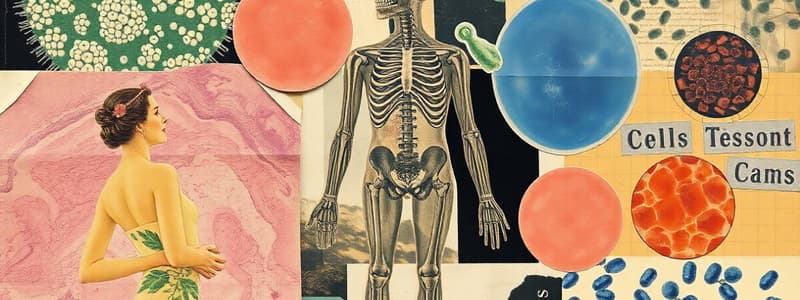Podcast
Questions and Answers
Which of the following is an example of the chemical level of structural organization in the human body?
Which of the following is an example of the chemical level of structural organization in the human body?
- Epithelial tissue
- The cardiovascular system
- The stomach
- Water molecules (correct)
The cellular level of organization includes various molecules combined to form the fluid and organelles of the body's cells.
The cellular level of organization includes various molecules combined to form the fluid and organelles of the body's cells.
True (A)
Name the four basic tissue types found in the human body.
Name the four basic tissue types found in the human body.
Epithelial, connective, muscle, and nervous.
__________ tissue is specialized for contraction and movement.
__________ tissue is specialized for contraction and movement.
Match the organ system with its primary function:
Match the organ system with its primary function:
Which of the following is a component of the nervous system?
Which of the following is a component of the nervous system?
The endocrine system primarily functions to deliver oxygen and nutrients to tissues.
The endocrine system primarily functions to deliver oxygen and nutrients to tissues.
What is the main function of the lymphatic system?
What is the main function of the lymphatic system?
The __________ system removes carbon dioxide from the body and delivers oxygen to the blood.
The __________ system removes carbon dioxide from the body and delivers oxygen to the blood.
Which level of structural organization is the highest and represents the whole person?
Which level of structural organization is the highest and represents the whole person?
Flashcards
Chemical level
Chemical level
The simplest level, involving atoms bonding to form molecules with three-dimensional structures. Includes subatomic particles, atoms, and molecules.
Cellular level
Cellular level
Molecules combine to form the fluid and organelles of the body’s cells. Cells are the smallest independently functioning units of a living organism.
Tissue level
Tissue level
Groups of similar cells working together to perform a specific function. Includes epithelial, nervous, muscular, and connective tissues.
Organ level
Organ level
Signup and view all the flashcards
Organ system level
Organ system level
Signup and view all the flashcards
Organism level
Organism level
Signup and view all the flashcards
Epithelial tissue
Epithelial tissue
Signup and view all the flashcards
Nervous tissue
Nervous tissue
Signup and view all the flashcards
Muscular tissue
Muscular tissue
Signup and view all the flashcards
Connective tissue
Connective tissue
Signup and view all the flashcards
Study Notes
- The human body has six levels of structural organization, increasing in complexity.
Chemical Level
- Atoms bond to create molecules with 3D structures.
- The study of the chemical level requires examining matter's most basic components.
- Subatomic particles, atoms, and molecules are crucial parts of this level.
- Molecules serve as the building blocks for all bodily structures.
Cellular Level
- Molecules combine to form the fluids and organelles of the body's cells.
- Cells represent the smallest independently functioning units in a living organism which even bacteria possess.
- Cytoplasm is a water-based fluid in cells which contains different functioning units called organelles.
- Cells perform all functions of life in all organisms including humans.
Tissue Level
- Similar cells form body tissues.
- Tissues are groups of similar cells working together for a specific function.
- There are four primary tissue types in the human body.
- Epithelial tissue consists of closely packed cells, covering body surfaces like skin, providing protection, secretion, excretion, filtration, and absorption.
- Nervous tissue consists of neurons and glial cells, transmitting signals and information to other cells.
- Muscular tissue consists of elongated, excitable cells specialized for contraction and movement which facilitates various functions like digestion, breathing, and blood circulation.
- Skeletal muscle is voluntary, while cardiac and smooth muscle are involuntary.
- Connective tissue connects, separates, and supports other tissues, with cells loosely arranged in an extracellular matrix.
Organ Level
- Organs are formed when two or more different tissues combine.
- Each organ is an anatomically distinct structure.
- Organs perform one or more specific physiological functions.
Organ System Level
- Multiple organs work together to perform major bodily functions
- The human body contains has 11 organ systems.
- The integumentary system includes skin, hair, and nails, and contains sensory receptors.
- The skeletal system which contains cartilage, bones, and joints supports body movement and structure.
- The muscular system which contains tendons and skeletal muscles enables movement and maintains body temperature.
- The nervous system includes CNS & PNS: brain, spinal cord, and peripheral nerves, detects and processes sensory information.
- The endocrine system includes: pituitary, thyroid, adrenal glands, pancreas, ovaries, and testes, secretes hormones, and regulates body processes.
- The cardiovascular system contains the heart and blood vessels, delivering oxygen and nutrients to tissues.
- The lymphatic system contains the thymus, lymph nodes, spleen, and lymphatic vessels, returning fluid to the blood and defending against pathogens.
- The respiratory system contains the nasal passage, trachea, and lungs, removes CO2 and delivers O2 to the blood.
- The digestive system which contains the stomach, liver, gall bladder, pancreas, large and small intestine, processes food, and removes waste.
- The urinary system includes the kidneys and urinary bladder, controlling water balance and removing waste from blood.
- Male reproductive system produces sperm and the female reproductive system produces sex hormones and eggs.
Organism Level
- Organ systems function harmoniously to sustain the independent organism.
- The organism level represents the highest level of organization.
Studying That Suits You
Use AI to generate personalized quizzes and flashcards to suit your learning preferences.




